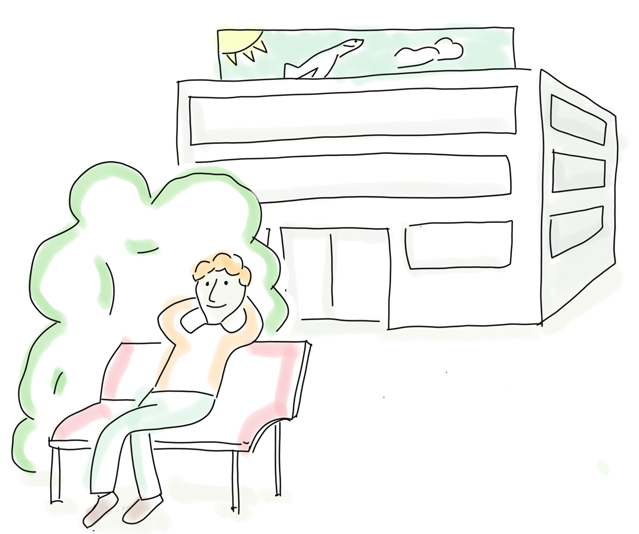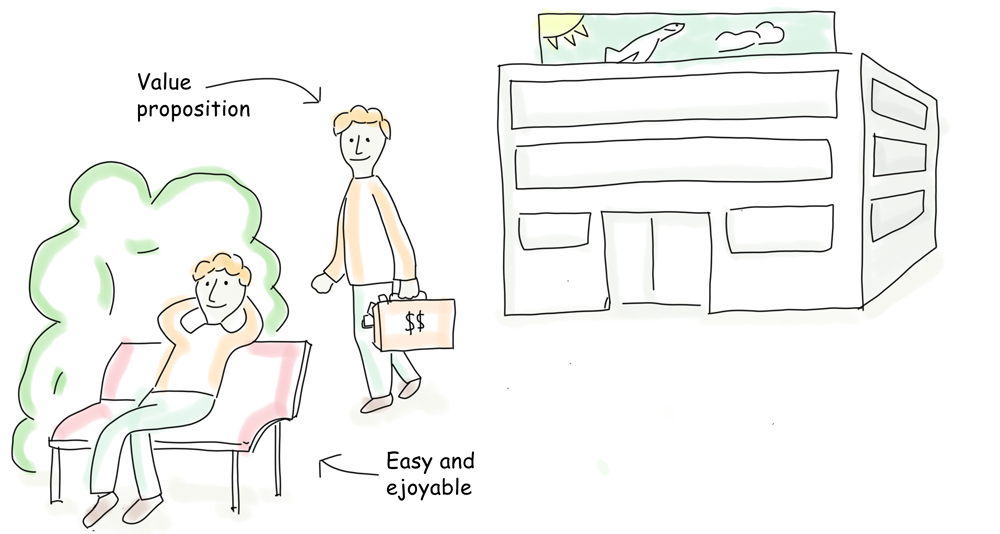The stuff I find most exciting is making something work for the users or to put it in more modern terms: people have a great experience when using something I helped create. So I focus on users and user experience. Some people rather talk about customers and customer experience. Whatever the name, it is basically the same isn’t it?

Person meets company
Things are quite easy: on the one hand we have people with their lives, work and dreams and on the other hand we have companies with their products and services, organisation and culture.

When the entities meet, there is quite a lot going on.
- First, the person, as a customer, experiences the interaction with the company.
- Second the person experiences the product and services of the company when using them.
- Third, the person also experiences underlying values or messages that go with this and form the brand.
The facets users, customers, and fans
An online store selling other companies’ products can do little about how it is to use the produts themselves. Such a store has a strong focus on our customer side and will make it easy for us to happily spend our last obol on the products with the highest margin.
A manufacturer of a product distributed via such a store can do little about the customer experience of the store. The creator can do a lot about the experiences users have when using the product. Thus such companies focus on our user side and find new ways of improving our lives and make the one or the other dream come true.
A producer of soft drinks apparantly relies yet on another aspect. At least some studies showed that, when testing blindfolded, quite a few people preferred the taste of that soft drink they would have told you is the one they liked less. Such companies focus on our fan side. They instill a longing for the values or the social status the brand purveys. Car manufacturers, cloth labels, and sports shoes producers come to my mind as being very successful doing just the same thing.
Business gives focus
The products and the market context defines, where a company will put its focus.
The video games creator of the last millenium had their revenue stream from selling the game. Entertaining games attracted more players, lead to bigger fan communities and this created new customers for the game and the sequels to follow. The focus was on the user – the gamer – and how to make a great game for them.
Nowadays, there seem to be a trillion games in the app store for free. The creators cash in on in-app content. The game needs to be good enough, certainly. But the innovation – with a lot of psychological tricks – goes into creating an environment, were the big fish, the whales, get addicted to spending thousands of euros for loot boxes, special weaponry, and much more. The focus and the innovation goes into the customer side.
A telco provider is providing us the possibility to communicate over distance. In the earlier days of telecommunication, users experienced the service through the operators and the provided phones. Nowadays, having a huge variety of apps on our phones, the telco provider is almost non-existent from a user perspective unless something does not work to plan. We interact with such companies mostly just as customers of their services.
Consequentially they put a lot of energy into innovating their stores and services, making buying and paying for the services easy. For them, our user side, i.e. how we bridge the distance between ourselves and others, is mostly left to other companies and these companies make the money.
Focus changes where companies innovate
A company looking at their customers will come up with different innovations than one looking at users or their fans. And that is quite natural.
For example, a cinema seen form a customer perspective, is a place to sell movies and popcorn. Seen from the user side, it could be a place to enjoy a great evening with friends and family, to get a glimpse of the glamour of Hollywood or to have a some deeper insights into life.
Thus the very way a company looks at the people outside frames the thinking:
- customer: make it easy and enjoyable for us to happily spend our last obol on the products with the best margin.
- user: find new ways of how we live our lives, do our work and make the one or the other dream come true.
- fan: instill a longing for the values the brand purveys and make us their biggest fans.
There are important differences
It looks like customer and user, even so they may be the exact same person, can be totally different from the viewpoint of a company:
| Customer | User |
| We look at buying behaviour, customer jurneys, touch points and how customers interact with the company. | We look at users’ lives, work and dreams and how products and services change these things. |
| Our metrics are Conversion Rate, Net Promoter Score or ratings in the App Store. | We use UX metrics like attractiveness, ease of learning, pragmatic quality and more. |
| We innovate how we interact with our customers so customers promote us and buy more and more of our services and products. | We identify needs people never knew they had and innovate how people live their lives and do their work so they are more productive, happier, engaged. |
Just as a side note: The results for metrics from the customer side like conversion rate can stem from completely different causes. E.g A low conversion rate can stem from bad shop design, too high prices, a campaign that attracted the wrong people, a product or service that is not good enough, bad press and much more.
The roles user, customer and fan
So far, customers, users and fans were just different facets of how we who develop and sell products perceive a person. You could also argue that customer, user and fans are roles. E.g. a parent buying a toy for a kid will have the role customer and the kid playing with the toy the role user. A grand-parent seeing how much fun the kid has and fully approving the companies value might take the role fan.
For equipment on the professional market, such a role separation is the standard case. Customers are usually persons within companies who do not use the product themselves. They buy the products because these fulfill some business need. Fans can be on any level, the higher up in the hierarchy the fans are, the better.
Strategic customers and daily level users
The strategic decisions around product are mainly about the customer side: what business need to address, what types of customers to contact, how to setup the business model to work with these customers etc. The goal is to find market segments big enough and homogeneous enough for a working business model. The value proposition of a product addresses the customer’s business situation.
However, while customers put a product on their short list mainly because of how well it fulfills their business needs, the decision to buy now includes a whole lot of other components as well. The two to mention in this article obviously are the fans, who vote for their favorite products even against stronger competition and the users who will vote for the products they think will make their life and work the easiest.
It follows that, for product design, looking very closely at user needs and how to make their lives easier and more enjoyable can be the tipping point for a customer to buy the product.

If you like an example, the case of a relevant UX problem, talks about one product development were the understanding of customer needs (doing a speedy job) and making users life easier and more enjoyable went hand in hand.
Customers, users and fans are really different
Customers, users and fans are completely different facets or roles, even though they may even be the same person. And in reality, it is even more differentiated.
For a hearing aid, you could distinguish between the following users: the patient, i.e. the person wearing the hearing aid; the significant other, i.e. the person who makes sure the user wants and uses the hearing aid, usually the spouse; and the fitter, i.e. the person who chooses the hearing aid, sells it to the user, and does troubleshooting. Obviously there might be completely different kinds of customers. The fitter or at least the shop owner is probably a customer as well.
Thus make sure that you have the right value proposition for you customers, make the users lifes easier and create big fans.